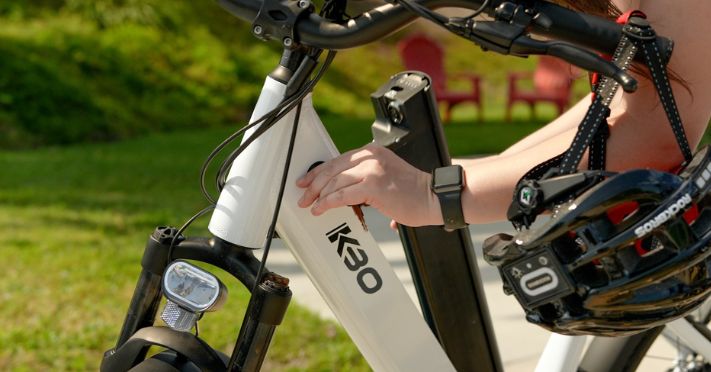An important driver of a well-performing e-bike is — drumroll, please — the battery.
The battery’s anodes, cathodes, and engineering design mean your machine continues operating at peak efficiency. A well-maintained battery provides enough volts, watts, and amp hours to power your ride effectively.
But as the saying goes, all good things come to an end. Your e-bike’s battery isn’t immune to wear, tear, and aging. When it comes time to say goodbye to your battery, following proper, safe battery disposal methods helps keep dangerous products out of landfills and supports reusing needed materials.
The Battery Evolution
Early e-bikes relied on power from lead-acid batteries. These weren’t all that different from car batteries. But these were heavy and inefficient.
As time passed, manufacturers shifted to nickel-cadmium batteries and, eventually, lithium-ion batteries, making them more compact and reliable.
The good news is that these newer batteries can deliver up to 1,000 rides when adequately treated. Depending on how often you ride – and where – a well-maintained battery can last up to five years.
That five-year deadline isn’t in stone, however. Signs that your e-bike’s battery might be nearing the finish line include:
- Notable decrease in performance
- Longer charge time
- Fast-draining charge
If your e-bike battery demonstrates any of the above symptoms, use a multimeter to test voltage, current, and amps. If you don’t own a multimeter, take your machine to the local e-bike shop and ask the mechanic there to check it for you. If voltage, current, and amps are lower than the manufacturer’s recommendations, it is time to bid your battery adieu.
Environmental Impact of Batteries
You might be tempted to put your battery in the household trash or drive it to the local dump. If you’re especially eco-minded, that battery could end up in your recycling bin.
These aren’t the proper methods to dispose of your battery. For one thing, they’re potentially illegal. For another, these disposal techniques are dangerous.
From a legal standpoint, many states have legislation to keep batteries out of landfills. Some of this legislation mandates battery recycling. Others require battery manufacturers and producers to offer or fund recycling services. Depending on where you reside, you could break the law if you improperly dispose of an e-bike battery.
If that weren’t enough, improper battery disposal creates huge environmental problems. E-bike batteries contain cobalt, graphite, and lithium. They’re great for powering your machine. Not so much when residing in landfills.
As the batteries corrode, these materials leach into groundwater and soil. Furthermore, putting these materials into household trash or recycling means they might be damaged or crushed in transport. This can lead to fire and explosion hazards.
Safe Battery Disposal Methods
There is a growing demand for materials used in Li-ion batteries. It’s not just e-bike batteries that use them. They also power smartphones and laptops. Supply chain disruptions could be problematic. Recycling e-bike batteries is one way to harvest these materials for reuse.
Until recently, there weren’t comprehensive manufacturer battery programs for recycling e-bike batteries. In late 2021, PeopleforBikes joined forces with Call2Recycle and launched an industry-wide bicycle battery recycling program. Through this voluntary program, battery manufacturers track each product sold and pay a per-battery fee to Call2Recycle. This helps Call2Recycle cover recycling costs, including materials, containers, and shipping.
Under this program, if your battery is damaged or reaches the end of its useful life, you can take it to a participating retail store. From there, it’s shipped to a Call2Recycle partner.
There are more than 1,800 in-person retail drop-off locations in the United States. You can also visit Call2Recycle’s website to learn which manufacturers and brand owners are involved in the program.
On a related topic, you might think that repairing your e-bike battery could give it a second life, while reducing the need for disposal. There are a couple of problems with this line of thought. First, Li-ion battery repair is difficult and unsafe. Second, repairing or opening the battery could void its warranty.
E-Bike Battery Maintenance
Proper care of your e-bike’s battery can extend its life. This means you use fewer batteries, meaning less worry about proper disposal. Best practices for battery maintenance include:
The right storage temperature
The ideal temperature for e-bike battery storage is between 40 degrees and 70 degrees Fahrenheit. This might be a little cool for most people, so room temperature is also acceptable. Leaving your battery exposed to hot temperatures can lead to capacity loss. At the other end of the thermometer spectrum, very cold conditions mean the battery’s electrolytes become dense, slowing the ions down and impacting performance.
Proper charging
Charging your battery to full capacity all the time might seem like a good idea. In reality, doing so can reduce the battery’s life, especially if you don’t use your machine within a day or two of charging. Generally a 60% to 80% ensures your e-bike is ready to go when you are. At the low end, it’s a good idea to keep the charge above 40%. Meanwhile, avoid charging 100% if you’re storing your e-bike for a long period.
Keeping it clean
Clean your battery regularly by wiping it down with a damp cloth and regularly greasing its terminals and connections. Also, keep other e-bike components clean. Riding your machine with a dirty chain or mud-clogged drivetrain means less efficiency and more juice from your battery.
Riding Toward Suitable E-Bike Riding
One benefit of electric bicycles is that they offer an eco-friendly substitute to the gas-consuming automobile. However, improper disposal of a dead or damaged battery can create many environmental problems. The best maintenance practices can extend e-bike battery life. And once that battery is no longer functional, responsible recycling keeps dangerous products out of landfills while potentially repurposing them for other uses.



